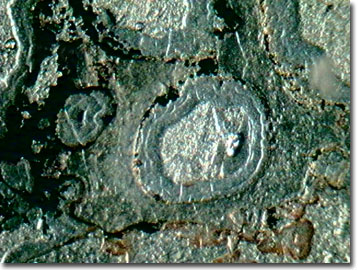Darkfield Digital Image Gallery
Pleistocene Mammal Bone From Florida
During the Pleistocene in the Cenozoic Era, ranging from 1.8 million years ago to as recently as 11,000 years ago, extant and extinct mammals coexisted with prehistoric humans. As with any other fossilized bones, the Pleistocene mammal bones underwent petrification or mineralization.

View a high magnification image of a Pleistocene mammal bone from Florida.
Slowly, decomposing calcium and phosphorus structures were broken down in an aqueous solution and the structure was held long enough for dissolved mineral material to be absorbed, and with the loss of water, precipitated out. Thus, the original biological structure of the bone is preserved with replacement minerals, but sometimes some of the hardest bone material remains intact in the fossil. This may preserve some of the organic material from the Pleistocene mammal and may even include genetic material such as DNA fragments. This fossilization process helps explain why Pleistocene mammal bone fossils are found in rich deposits along Florida's rivers and karst spring areas.
Quaternary megafaunal mammals that are extinct, but known from Florida, included the shortlimbed llama (Palaeolama mirifica), large-headed llama (Hemiauchenia macrocephala), mastodon (Mammut americanum), mammoth (Mammuthus imperator), long-horned bison (Bison latifrons), Ice Age bison (B. antiquus), horse (Equus species), tapir (Tapirus veroensis), peccaries (Mylohyus and Platygonus species), giant ground sloth (Eremotherium mirabile), Harlan's ground sloth (Paramylodon harlani), armadillo-like glyptodont (Boreostrocon floridanus), giant armadillo (Holmesina floridanus), saber-toothed cat (Smilodon fatalis), jaguar (Panthera onca), and dire wolf (Canis dirus). The fossilized mammal bone illustrated here was not identified to species.
Extensive expeditions such as the underwater studies since 1983 on the Panhandle's Aucilla River (west of Tallahassee) by the Florida Museum of Natural History, Florida State University, and the University of Florida have revealed what the Pleistocene Florida megafauna may have looked like. Some of these Pleistocene mammals coexisted with the first Paleo-Indians that entered Florida about 12,000 years ago and the Aucilla River sites feature a mastodon butcher site and a wide assortment of bone and stone tools as well as the remains of prehistoric bison and mastodons bearing signs of human hunting. Apparently, during drier times, the river was reduced to a series of sinkholes that served as watering holes where Pleistocene mammals congregated, and this certainly made the hunting of large mammals easier.
Contributing Authors
Cynthia D. Kelly, Thomas J. Fellers and Michael W. Davidson - National High Magnetic Field Laboratory, 1800 East Paul Dirac Dr., The Florida State University, Tallahassee, Florida, 32310.
BACK TO THE DARKFIELD IMAGE GALLERY
BACK TO THE DIGITAL IMAGE GALLERIES
Questions or comments? Send us an email.
© 1995-2025 by Michael W. Davidson and The Florida State University. All Rights Reserved. No images, graphics, software, scripts, or applets may be reproduced or used in any manner without permission from the copyright holders. Use of this website means you agree to all of the Legal Terms and Conditions set forth by the owners.
This website is maintained by our
Graphics & Web Programming Team
in collaboration with Optical Microscopy at the
National High Magnetic Field Laboratory.
Last Modification Friday, Nov 13, 2015 at 01:19 PM
Access Count Since September 17, 2002: 15108
Visit the website of our partner in introductory microscopy education:
|
|
